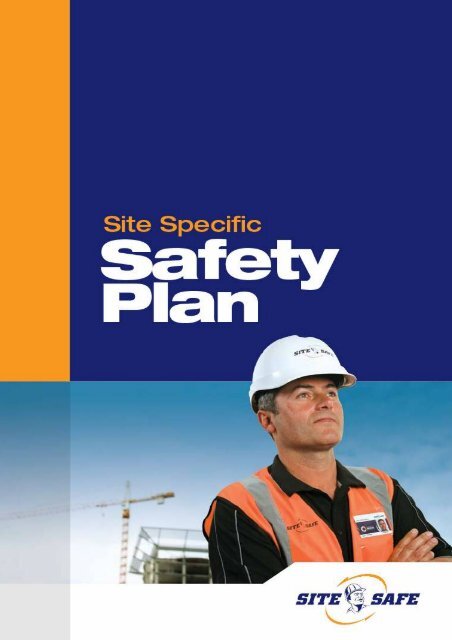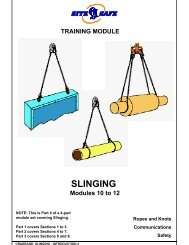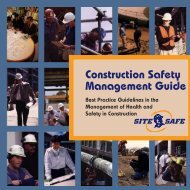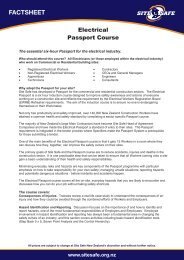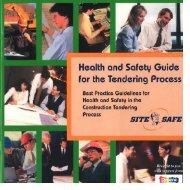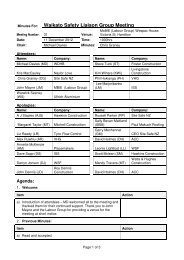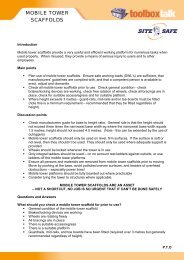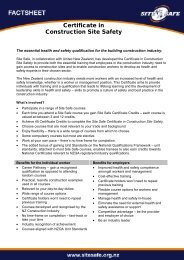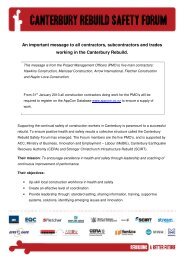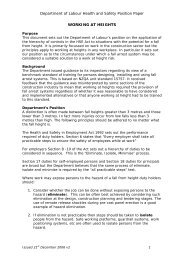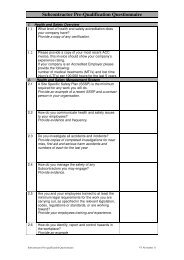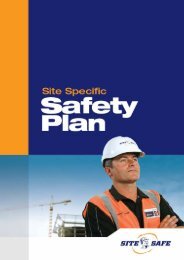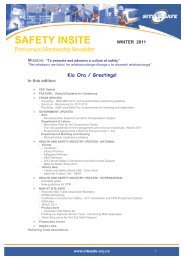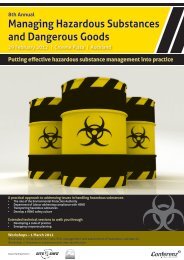Site Specific Safety Plan - Site Safe
Site Specific Safety Plan - Site Safe
Site Specific Safety Plan - Site Safe
Create successful ePaper yourself
Turn your PDF publications into a flip-book with our unique Google optimized e-Paper software.
A <strong><strong>Safe</strong>ty</strong> <strong>Plan</strong> to Suit Your Job<br />
Contents<br />
FORMS TITLE PAGE<br />
<strong>Site</strong> <strong>Specific</strong> <strong><strong>Safe</strong>ty</strong> <strong>Plan</strong> (SSSP) Explanatory Notes 3<br />
1. <strong>Site</strong> <strong>Specific</strong> <strong><strong>Safe</strong>ty</strong> <strong>Plan</strong> Checklist 5<br />
2. Hazard Register 7<br />
3. Notification of Particular Hazardous Construction Work 8<br />
4. Hazardous Substance/Dangerous Goods Register 10<br />
5. Task Analysis Worksheet 11<br />
5a. Task Analysis Sign-off 13<br />
6. Toolbox <strong><strong>Safe</strong>ty</strong> Meeting Minutes 14<br />
7. Pre-start <strong>Site</strong> Assessment 15<br />
8. Self <strong><strong>Safe</strong>ty</strong> Inspection Checklist 17<br />
9. Emergency <strong>Plan</strong> and Procedures for Hazardous Work 19<br />
9a. Emergency Evacuation <strong>Plan</strong> 20<br />
10. Accident/Incident Register 21<br />
11. Notice or Record of Accident/Serious Harm 22<br />
12. Accident and Incident Investigation Report 23<br />
13. <strong><strong>Safe</strong>ty</strong> Training and Competency Register 25<br />
14. <strong>Site</strong> Induction Register 26<br />
15. <strong><strong>Safe</strong>ty</strong> Activity Monitoring Register Wall Chart 27<br />
15a. Wall Chart Senior Manager Review Sign-off 28<br />
16. <strong>Site</strong> <strong>Specific</strong> <strong><strong>Safe</strong>ty</strong> <strong>Plan</strong> Evaluation 29<br />
Definitions of Terms 31<br />
Contact List 32<br />
<strong>Site</strong> <strong>Safe</strong> Training to Assist You in Understanding and Completing a <strong>Site</strong><br />
<strong>Specific</strong> <strong><strong>Safe</strong>ty</strong> <strong>Plan</strong><br />
33<br />
<strong>Site</strong> <strong>Safe</strong> Office Contact Details 34<br />
October 2012 Page 1
NOTES:<br />
October 2012 Page 2
<strong>Site</strong> <strong>Specific</strong> <strong><strong>Safe</strong>ty</strong> <strong>Plan</strong> (SSSP) Explanatory Notes<br />
This document must be maintained and reviewed throughout the duration of the project.<br />
The <strong>Site</strong> <strong>Specific</strong> <strong><strong>Safe</strong>ty</strong> <strong>Plan</strong> Checklist (form 1) contains Yes or No check boxes.<br />
Where there is a Yes/No option, a response must be given.<br />
Tick the Actioned box when the subcontractor has completed the required action.<br />
All items must be responded to in order to sign off the <strong>Site</strong> <strong>Specific</strong> <strong><strong>Safe</strong>ty</strong> <strong>Plan</strong> (SSSP).<br />
Once the SSSP is signed off, site access can be granted to the subcontractor.<br />
1. Workplace Control and Health and <strong><strong>Safe</strong>ty</strong> Management (<strong><strong>Safe</strong>ty</strong> Activity Monitoring<br />
Register Wall Chart – form 15)<br />
The person who is designated to act on behalf of your business for safety on site may be a dedicated safety representative,<br />
your supervisor, or one of your employees. This person must actively promote safety in the workplace and ensure<br />
appropriate safe work practices for on-site personnel, log activities on the <strong><strong>Safe</strong>ty</strong> Activity Monitoring Register and complete<br />
all inspections scheduled on the <strong><strong>Safe</strong>ty</strong> Activity Monitoring Register.<br />
Persons in control of the workplace. The subcontractor must identify the person who has control of the workplace and<br />
confirm this on form 1 of this SSSP. This will often be the project’s principal, but if the work is being done directly for a client<br />
on their premises, then the employer in control of the site may be the client or building owner. The people in control of the<br />
workplace, and their site representative, have the overall responsibility for health and safety management for the site, which<br />
will include managing most of the items in the SSSP Checklist and co-ordination of all trades’ health and safety.<br />
2. Notifiable Works (DoL Notification of Particular Hazardous Construction Work – form 3;<br />
Task Analysis Worksheet – form 5)<br />
Where Notifiable Work (as defined in sections 2 and 26 of the Health and <strong><strong>Safe</strong>ty</strong> in Employment Regulations 1995) is to be<br />
carried out by your business, you must notify the Department of Labour (DoL) in writing at least 24 hours before starting such<br />
work. <strong>Site</strong> management will require confirmation that you have done this. You must provide a copy of the Notification and a<br />
Task Analysis Worksheet for their records. If you are carrying out Notifiable Work, then you must have a full-time on-site<br />
safety representative and he/she must be the holder of the <strong>Site</strong> <strong>Safe</strong> Advanced Passport, the Supervisor Gold Card or the<br />
BCITO National Certificate in Construction Health and <strong><strong>Safe</strong>ty</strong> and Injury Prevention.<br />
3. Hazard Management (Task Analysis Worksheet – form 5; Hazard Register – form 2;<br />
Hazardous Substance/Dangerous Goods Register – form 4)<br />
All hazards to be brought onto the site or created during the course of the work must be identified and controlled. The<br />
standard Task Analysis Worksheet may be used to analyse the various tasks within your trade work, identify the significant<br />
safety hazards and detail the method of control. These sheets must be attached and forwarded with your SSSP.<br />
A Hazardous Substance/Dangerous Goods Register must be maintained with the appropriate <strong><strong>Safe</strong>ty</strong> Data Sheet (SDS)<br />
attached. If specific emergency processes need to be set up, this will be addressed on the Task Analysis Worksheet and in<br />
an attached Emergency <strong>Plan</strong> (form 9) to be incorporated into the project emergency planning and evacuation processes.<br />
4. Communication/Employee Participation (Toolbox <strong><strong>Safe</strong>ty</strong> Meeting Minutes – form 6)<br />
On-site safety requirements must be communicated to all site personnel. This will include the notification of hazards brought<br />
onto the site or created during the course of the work. Do this by posting hazards on the main site hazard board, or advising<br />
staff during regular safety meetings. The aim is to ensure that all workers on site are aware of the hazards as they arise and<br />
are advised when they no longer exist. If English is the second language of any of your employees, then you must maintain<br />
a liaison person on site who can effectively communicate between them and the site management team.<br />
5. Emergencies (Emergency <strong>Plan</strong> – form 9; Emergency Evacuation <strong>Plan</strong> – form 9a)<br />
In the event of a site evacuation, the Emergency Evacuation Alarm will be sounded and your employees must promptly<br />
evacuate the site. The site management team will notify you of your assembly point at the time of your induction onto the<br />
site.<br />
October 2012 Page 3
Some emergencies that you may need to prepare for, and have a procedure to deal with, include spillage of hazardous<br />
substances, serious harm accidents to your staff, and rescue of a fall arrest victim. Each potential emergency you identify<br />
under your hazard management process in section 3 of form 1 must have an emergency plan and procedure prepared and<br />
included with the hazard management information submitted so that any effect it may have on the Emergency Evacuation<br />
<strong>Plan</strong> can be identified and rectified.<br />
You must have a person on site trained in First Aid, with a current valid certificate, in case of an injury or accident.<br />
6. Accident/Incident Reporting (Accident/Incident Register – form 10; Notice or Record of<br />
Accident/Serious Harm – form 11; Accident and Incident Investigation Report – form 12)<br />
All accidents and incidents must be reported immediately to site management. Accident and Incident Investigation Reports<br />
are to be given to site management as soon as is practicable. You must also report serious harm accidents directly to DoL.<br />
In the case of serious harm accidents, the scene must not be disturbed until a full and complete accident investigation has<br />
been undertaken.<br />
7. <strong><strong>Safe</strong>ty</strong> Inspections and <strong><strong>Safe</strong>ty</strong> Reviews (Self <strong><strong>Safe</strong>ty</strong> Inspection Checklist – form 8; Pre-start <strong>Site</strong> Assessment –<br />
form 7; <strong><strong>Safe</strong>ty</strong> Activity Monitoring Register Wall Chart – form 15)<br />
You are required to carry out regular, documented safety inspections of your own work areas while on site, at the intervals<br />
scheduled in the <strong><strong>Safe</strong>ty</strong> Activity Monitoring Register Wall Chart. Copies of the Accident and Incident Investigation Report<br />
must be given to site management for discussion at safety meetings. Any recommended/completed corrective action will be<br />
advised at these meetings.<br />
8. Training/Induction (<strong><strong>Safe</strong>ty</strong> Training and Competency Register – form 13)<br />
All persons starting work on this site must go through a formal induction process. During this process, safety rules and<br />
various site specific issues will be discussed.<br />
To work on a site you must have a current site access card such as the <strong>Site</strong> <strong>Safe</strong> Passport, Advanced Passport or<br />
Supervisor Gold Card. Please supply a list of all your employees working on this site, along with their access card numbers<br />
and expiry dates at the time of the induction. All employees will be expected to show their <strong>Site</strong> <strong>Safe</strong> access cards at<br />
induction.<br />
You will need to provide and maintain evidence of your employees’ skills training, e.g. trade<br />
qualifications, certificate of competency, etc.<br />
9. Sign-off/Approval<br />
Before any work commences on site, the subcontractor will sign off their SSSP and submit it with all attachments to the<br />
principal/site management for approval.<br />
The principal/site management will review the plan using the <strong>Site</strong> <strong>Specific</strong> <strong><strong>Safe</strong>ty</strong> <strong>Plan</strong> Evaluation (form 16) and return it to<br />
the subcontractor if not complete, or request a meeting with the subcontractor to review and action any deficiencies.<br />
Once all the evaluation checks have been satisfactorily agreed, the principal/site management will sign and date the SSSP<br />
confirming approval and return a signed copy to the subcontractor for their record.<br />
10. Subcontractors<br />
The subcontractor must have a process in place for approving their own subcontractors’ safety systems. If the subcontractor<br />
contracts out some of their work to another subcontractor, then the site management must be notified in a schedule<br />
attached to the subcontractor’s SSSP of the names and contact details for all their subcontractors.<br />
October 2012 Page 4
1. <strong>Site</strong> <strong>Specific</strong> <strong><strong>Safe</strong>ty</strong> <strong>Plan</strong> Checklist<br />
To be completed and handed to principal/site management before start of work on site<br />
To: (Main contractor) For: (Project/<strong>Site</strong>)<br />
(Client)<br />
From: (Subcontractor) For: (Contracted works)<br />
(Contractor)<br />
(Delete which does not apply)<br />
We undertake as follows:<br />
1. Workplace Control and Management:<br />
On-site safety representative (SR) for this project is:………………………….……….…… (Phone) …....……...……...….<br />
The person in control of the workplace is: Principal/Client/Main contractor/Other ………….……..………………………<br />
2. Notifiable Works:<br />
We have Notifiable Works associated with our subcontract Yes No<br />
DoL has been advised of our Notifiable Works Yes No<br />
(A copy of the Notification (form 3) must be attached)<br />
Notification attached Yes No<br />
3. Hazard Management:<br />
We will maintain an on-site Hazard Register of all existing and new hazards and appropriate controls Yes No<br />
We will prepare a written Task Analysis covering all significant hazards associated with our works, in<br />
conjunction with employees, and give it to site management before any work involving that hazard<br />
commences on site Yes No<br />
Are there hazardous products/processes associated with our subcontract works? Yes No<br />
(If yes, the appropriate <strong><strong>Safe</strong>ty</strong> Data Sheets must be attached)<br />
4. Communication/Employee Participation:<br />
The methods we use to communicate safety information to our employees are:<br />
Toolbox Talks Pre-task planning meetings Health and safety meetings Co-ordination meetings<br />
Frequency……………. Frequency……………. Frequency……………. Frequency…………….<br />
Other ……………...………………………………………….Frequency ….……………………………………………….….<br />
5. Emergencies:<br />
Our First Aid kit is located at: …….……….…………………………………………...……………………………………………<br />
Our First Aid person is: ……………………………………………………………………(Phone) ………………………………..<br />
We have trained First Aid personnel and procedures in place on site to render assistance in the<br />
event of an accident/ emergency Yes No<br />
We have attached an Emergency <strong>Plan</strong> for all hazardous products and processes we have said<br />
yes to in section 3 above Yes No<br />
In the event of a site emergency or evacuation our personnel will report to our safety representative<br />
and assemble at the evacuation area shown on the Emergency Evacuation <strong>Plan</strong> Yes No<br />
6. Accident/Incident: Reporting/Investigation/Recording:<br />
We have an accident/incident reporting/investigation system in place and keep an Accident/Incident<br />
Register Yes No<br />
We will immediately notify all serious harm accidents to site management and follow up within 7<br />
days with a completed copy of the Accident and Incident Investigation Report Yes No<br />
October 2012 Page 5
7. <strong><strong>Safe</strong>ty</strong> Inspections and <strong><strong>Safe</strong>ty</strong> Reviews:<br />
We agree to undertake safety inspections and reviews at the intervals required by the <strong><strong>Safe</strong>ty</strong><br />
Activity Monitoring Register Wall Chart Yes No<br />
A sample of documentation of our safety inspections is attached Yes No<br />
8. Training/Induction:<br />
All persons under our control hold a current <strong>Site</strong> <strong>Safe</strong> Passport, Advanced Passport or<br />
Supervisor Gold Card Yes No<br />
(See attached <strong><strong>Safe</strong>ty</strong> Training and Competency Register – form 13)<br />
All persons under our control on site are given a site specific safety induction Yes No<br />
All persons under our control on site are appropriately qualified, competent or fully supervised Yes No<br />
9. Subcontractors:<br />
Will you have subcontractors working for you on this project? Yes No<br />
(If yes, then attach a schedule of details for all subcontractors and agree to provide to the site management<br />
completed SSSPs from all your subcontractors for approval before they are allowed to work on the site)<br />
Signed: ………………………………………… Name: ………………………………………Date: ………………………..……<br />
(Subcontractor representative)<br />
Signed: ………………………………………… Name: ………………………………………Date: …………………………..…<br />
(Principal/<strong>Site</strong> project manager)<br />
Subcontractor Notes:<br />
Main Contractor Notes:<br />
<strong><strong>Safe</strong>ty</strong> Advisor Notes:<br />
October 2012 Page 6
2. Hazard Register<br />
PROJECT/SITE<br />
IDENTIFIED HAZARD<br />
POTENTIAL HARM<br />
SIGNIFICANT<br />
HAZARD<br />
E I M HAZARD CONTROLS REGULAR CHECK OF HAZARD CONTROLS IN PLACE<br />
Yes No<br />
Training<br />
Required<br />
Date<br />
Checked<br />
Date<br />
Checked<br />
Date<br />
Checked<br />
Date<br />
Checked<br />
October 2012 Page 7
Health and <strong><strong>Safe</strong>ty</strong> in Employment Regulations 1995<br />
3. Notification of Particular Hazardous Construction Work<br />
Please mail or fax this notification form to your nearest DoL branch. Sections 2 and 26 of the Health and <strong><strong>Safe</strong>ty</strong> in<br />
Employment Regulations 1995 define Notifiable Work and set out who is responsible for making the notification. They<br />
are also quoted on the back of this form for your convenience. (If faxing this form, please return only the front page.)<br />
Notification is hereby given under the Health and <strong><strong>Safe</strong>ty</strong> in Employment Regulations 1995 in<br />
respect of the following work:<br />
Nature of work (tick appropriate box):<br />
The erection or dismantling of scaffolding (all kinds) from<br />
which any person may fall 5 metres or more<br />
Buildings and structures where a fall of over 5 metres may<br />
occur<br />
Use of a lifting appliance to lift 500 kg or more a vertical<br />
distance of 5 metres or more<br />
Any narrow pit, shaft, trench or excavation more than 1.5<br />
metres deep<br />
Drive, excavation or heading with ground cover overhead<br />
Excavated face over 5 metres deep with a face steeper<br />
than 63.4° (1 horizontal to 2 vertical)<br />
Storage or use of explosives<br />
Work in, or breathing of, compressed air or air substitute<br />
Restricted work involving asbestos (as defined in<br />
Regulation 2(1) of the Asbestos Regulations 1998)<br />
Demolition<br />
Tree felling in land clearance<br />
Tree felling in maintenance of overhead power lines<br />
Other: ......................................................................................................................................................................................<br />
Address of worksite: .............................................................. Contractor Self-employed<br />
............................................................................................... Business name: .........................................................................<br />
…… ........................................................................................ Address: .....................................................................................<br />
Main access road: ................................................................. ...................................................................................................<br />
Location: ................................................................................ Contact: .....................................................................................<br />
................................................................................................ Phone: .................................. Fax: ........................................<br />
Principal/Employer: ............................................................... Certificate holder: ......................................................................<br />
Address: ................................................................................. Certificate no.: ............................................................................<br />
............................................................................................... Phone: .................................. Fax: ........................................<br />
(Please name certificate holder when notifying scaffolding,<br />
Contact: .................................................................................. diving, asbestos or use of explosives)<br />
Phone: ..................................... Fax: ...................................<br />
Brief description of work: ...............................................................................................................................................................<br />
.......................................................................................................................................................................................................<br />
................ .......................................................................................................................................................................................<br />
Due date of commencement: ______/______/______ Estimated time to complete: ………………………………………<br />
Date: ______/______/______<br />
Signed: ………………………………………………………………<br />
(For employer)<br />
DISCLAIMER: This form was correct as at November 2011. Please check www.osh.govt.nz for latest version.<br />
October 2012 Page 8
Department of Labour phone: 0800 20 90 20<br />
NORTHERN REGION<br />
Whangarei<br />
Level 2, Michael Hill<br />
Building<br />
25 Rathbone Street<br />
PO Box 141<br />
Whangarei<br />
Fax: (09) 438 4874<br />
Auckland North<br />
Level 5, ANZ building<br />
9 –11 Corinthian Drive<br />
Albany<br />
PO Box 301 012<br />
Albany<br />
Fax: (09) 909 3280<br />
CENTRAL REGION<br />
Hamilton<br />
Level 3, Westpac Building<br />
430 Victoria street<br />
PO Box 19 217<br />
Hamilton<br />
Fax: (07) 957 6401<br />
Bay of Plenty<br />
Tauranga Office<br />
Campbell House<br />
727 Cameron Road<br />
PO Box 66<br />
Tauranga<br />
Fax: (07) 577 6396<br />
Rotorua Office<br />
Zens Centre<br />
Level 7, 1135 Arawa St<br />
PO Box 2128<br />
Rotorua<br />
Fax: (07) 346 0229<br />
SOUTHERN REGION<br />
Wellington<br />
Wellington Office<br />
Level 1, 85 The Terrace<br />
PO Box 3705<br />
Wellington<br />
Fax: (04) 918 4715<br />
Lower Hutt Office<br />
Level 1, Professional<br />
Building<br />
33 Kings Cres<br />
PO Box 30 556<br />
Lower Hutt<br />
Fax: (04) 914 6866<br />
Nelson<br />
Level 1, 9 Buxton Square<br />
PO Box 180<br />
Nelson<br />
Fax: (03) 989 6789<br />
Christchurch<br />
Christchurch Office<br />
PO Box 13278<br />
Christchurch Fax: (03) 964<br />
7821<br />
NotifiableWork.CHCH@dol.<br />
govt.nz<br />
Auckland Central<br />
Level 9, 280 Queen St<br />
PO Box 105 146<br />
Auckland<br />
Fax: (09) 984 4115<br />
Auckland South<br />
1st floor, 12 Lambie Drive<br />
Manukau<br />
PO Box 63 010<br />
Manukau City<br />
Auckland 2241<br />
Fax: (09) 909 3248<br />
Napier<br />
Napier Office<br />
19 Bower Street<br />
PO Box 546<br />
Napier<br />
Fax: (06) 835 7102<br />
Gisborne Office<br />
Level 1, Wilson James<br />
Centre, 77 Peel Street<br />
PO Box 139<br />
Gisborne<br />
Fax: (06) 868 8832<br />
New Plymouth<br />
330 Devon St East<br />
PO Box 342<br />
New Plymouth<br />
Fax: (06) 759 9417<br />
Palmerston North<br />
L4, State Insurance<br />
Building 65 Rangitikei<br />
Street<br />
PO Box 12030<br />
Palmerston North<br />
Fax: (06) 952 3461<br />
Greymouth Office<br />
PO Box 13 278<br />
Christchurch<br />
Fax: (03) 964 7821<br />
Timaru Office<br />
77 Sophia Street<br />
PO Box 13 278<br />
Christchurch<br />
Fax: (03) 964 7821<br />
Dunedin<br />
Norwich House<br />
1 Bond Street<br />
PO Box 537<br />
Dunedin<br />
Fax: (03) 955 3274<br />
Invercargill<br />
70 Victoria Avenue<br />
PO Box 548<br />
Invercargill<br />
Fax: (03) 218 2152<br />
Addresses last<br />
updated<br />
November 2011<br />
Section 2 and 26 of the Health and <strong><strong>Safe</strong>ty</strong> in Employment<br />
Regulations 1995<br />
…<br />
2. Interpretation–<br />
“Notifiable work” means—<br />
(a) Any restricted work, as that term is defined in regulation 2(1) of<br />
the [Health and <strong><strong>Safe</strong>ty</strong> in Employment (Asbestos) Regulations<br />
1998]:<br />
(b) Any logging operation or tree-felling operation, being an<br />
operation that is undertaken for commercial purposes:<br />
(c) Any construction work of one or more of the following kinds:<br />
(i) Work in which a risk arises that any person may fall 5 metres or<br />
more, other than—<br />
(A) Work in connection with a residential building up to and<br />
including 2 full storeys:<br />
(B) Work on overhead telecommunications lines and overhead<br />
electric power lines:<br />
(C) Work carried out from a ladder only:<br />
(D) Maintenance and repair work of a minor or routine nature:<br />
(ii) The erection or dismantling of scaffolding from which any<br />
person may fall 5 metres or more:<br />
(iii) Work using a lifting appliance where the appliance has to lift a<br />
mass of 500 kilograms or more a vertical distance of 5 metres or<br />
more, other than work using an excavator, a fork-lift, or a selfpropelled<br />
mobile crane:<br />
(iv) Work in any pit, shaft, trench, or other excavation in which any<br />
person is required to work in a space more than 1.5 metres deep<br />
and having a depth greater than the horizontal width at the top:<br />
(v) Work in any drive, excavation, or heading in which any person<br />
is required to work with a ground cover overhead:<br />
(vi) Work in any excavation in which any face has a vertical height<br />
of more than 5 metres and an average slope steeper than a ratio of<br />
1 horizontal to 2 vertical:<br />
(vii) Work in which any explosive is used or in which any explosive<br />
is kept on the site for the purpose of being used:<br />
(viii) Work in which any person breathes air that is or has been<br />
compressed or a respiratory medium other than air:<br />
…<br />
26. Notification– (1)In this regulation, the term “employer” includes<br />
a person who controls a place of work.<br />
(2) Subject to subclause (4) of this regulation, every employer who<br />
intends to commence any notifiable work or any work that will at<br />
any time include any notifiable work shall take all practicable steps<br />
to lodge notice of that intention in accordance with this regulation.<br />
(3) A notice required to be lodged under subclause (2) of this<br />
regulation shall—<br />
(a) Be lodged at an office that deals with occupational safety and<br />
health matters, being the nearest such office of the Department to<br />
the place where the work is to be carried out; and<br />
(b) Be in writing; and<br />
(c) Be given at least 24 hours before the time at which the<br />
employer intends to commence the work; and<br />
(d) Contain the following particulars—<br />
(i) The nature and location of the work; and<br />
(ii) The name, address, and contact details of the employer; and<br />
(iii) The intended date of commencement of the work; and<br />
(iv) The estimated duration of the work.<br />
(4) It shall not be necessary for any employer to comply with<br />
subclause (2) of this regulation before commencing any<br />
construction work or tree felling operation necessary to deal with an<br />
emergency arising from—<br />
(a) Damage caused by any earthquake, explosion, fire, flood,<br />
lightning, rain, slip, storm, or washout; or<br />
(b) The blockage or breakdown of any drain or sewer; or<br />
(c) The blockage or breakdown of any distribution system or<br />
network for electricity, gas, telecommunications, or water.<br />
October 2012 Page 9
4. Hazardous Substance/Dangerous Goods Register (<strong><strong>Safe</strong>ty</strong> Data Sheets – SDS)<br />
PROJECT/SITE<br />
EMPLOYER<br />
Date<br />
Substance, Chemical,<br />
Material or Solvent<br />
“SDS” records concise health, safety and technical information held for all products used and stored by the organisation<br />
Supplier SDS<br />
Report Held<br />
Y/N<br />
Hazard Potential<br />
<strong>Safe</strong>r Alternative<br />
Protective Clothing<br />
Required<br />
Action<br />
Recommended<br />
Action<br />
Review<br />
Date<br />
Completion guide and action sign-off<br />
Completed <strong><strong>Safe</strong>ty</strong> Data Sheets are held for all products and the information, health risks and the directive to use protective equipment have been conveyed to employees and recorded in the<br />
<strong><strong>Safe</strong>ty</strong> Training and Competency Register……………..……………………..…………….……signed (<strong>Site</strong> management) ………………………..….(Date)<br />
For hazardous substance compliance information call ERMA on 0800 376 234<br />
October 2012 Page 10
5. Task Analysis Worksheet<br />
JOB DESCRIPTION PROJECT/SITE EMPLOYER DATE<br />
PPE required:<br />
<strong>Plan</strong>t required:<br />
Signage required:<br />
Task Analysis completed by:<br />
Date:<br />
SEQUENCE OF BASIC STEPS POTENTIAL SIGNIFICANT HAZARDS HAZARD CONTROL METHOD<br />
List the 4 to 8 steps required to complete the job<br />
(Follow the flow of the product or the process)<br />
Step<br />
No.<br />
List the potential SIGNIFICANT hazards beside each step. Focus<br />
on what can cause harm and what can go wrong<br />
(Use the Seven Point Analysis as a guide)<br />
Step<br />
No.<br />
List the control methods required to ELIMINATE,<br />
ISOLATE or MINIMISE each SIGNIFICANT hazard<br />
E/I/M<br />
Seven Point Analysis<br />
To help identify hazards, for each step ask – Can I?:<br />
strain or sprain my back or other muscle<br />
be caught in, on or between anything<br />
slip, trip or fall from height, on the same or lower level<br />
be injured by poor plant/job design<br />
be struck by or against anything<br />
come in contact with a hazardous substance<br />
come in contact with an energy source<br />
October 2012 Page 11
SEQUENCE OF BASIC STEPS POTENTIAL SIGNIFICANT HAZARDS HAZARD CONTROL METHOD<br />
List the 4 to 8 steps required to complete the job<br />
(Follow the flow of the product or the process)<br />
Step<br />
No.<br />
List the potential SIGNIFICANT hazards beside each step. Focus<br />
on what can cause harm and what can go wrong<br />
(Use the Seven Point Analysis as a guide)<br />
Step<br />
No.<br />
List the control methods required to ELIMINATE,<br />
ISOLATE or MINIMISE each SIGNIFICANT hazard<br />
E/I/M<br />
October 2012 Page 12
5a. Task Analysis Sign-off<br />
All persons involved in Task Analysis have been trained in the processes<br />
Name………………………………………Signature…………………………………….……….<br />
Name………………………………………Signature…………………………………….……….<br />
Name………………………………………Signature…………………………………….………. Name………………………………………Signature…………………………………….……….<br />
Name………………………………………Signature…………………………………….………. Name………………………………………Signature…………………………………….……….<br />
Name………………………………………Signature…………………………………….………. Name………………………………………Signature…………………………………….……….<br />
Name………………………………………Signature…………………………………….………. Name………………………………………Signature…………………………………….……….<br />
Name………………………………………Signature…………………………………….………. Name………………………………………Signature…………………………………….……….<br />
Name………………………………………Signature…………………………………….………. Name………………………………………Signature…………………………………….……….<br />
Name………………………………………Signature…………………………………….………. Name………………………………………Signature…………………………………….……….<br />
Name………………………………………Signature…………………………………….………. Name………………………………………Signature…………………………………….……….<br />
Name………………………………………Signature…………………………………….………. Name………………………………………Signature…………………………………….……….<br />
Name………………………………………Signature…………………………………….……….<br />
Name………………………………………Signature…………………………………….……….<br />
Name………………………………………Signature…………………………………….………. Name………………………………………Signature…………………………………….……….<br />
Name………………………………………Signature…………………………………….………. Name………………………………………Signature…………………………………….……….<br />
Name………………………………………Signature…………………………………….………. Name………………………………………Signature…………………………………….……….<br />
Name………………………………………Signature…………………………………….………. Name………………………………………Signature…………………………………….……….<br />
Name………………………………………Signature…………………………………….………. Name………………………………………Signature…………………………………….……….<br />
Name………………………………………Signature…………………………………….………. Name………………………………………Signature…………………………………….……….<br />
Name………………………………………Signature…………………………………….………. Name………………………………………Signature…………………………………….……….<br />
Name………………………………………Signature…………………………………….………. Name………………………………………Signature…………………………………….……….<br />
October 2012 Page 13
6. Toolbox <strong><strong>Safe</strong>ty</strong> Meeting Minutes<br />
Various Toolbox Talks are available to <strong>Site</strong> <strong>Safe</strong> members on the <strong>Site</strong> <strong>Safe</strong> website: www.sitesafe.org.nz<br />
PROJECT/SITE<br />
FOREMAN/SUPERVISOR<br />
EMPLOYER<br />
DATE<br />
PRINCIPAL<br />
Attendees:<br />
Signatures of attendees:<br />
<strong>Site</strong> activity/safe work practices/accident/incident investigations discussed:<br />
Employee issues raised:<br />
Date to be resolved by:<br />
<strong>Safe</strong> observations reviewed/discussed:<br />
Task Analysis completed/reviewed:<br />
Date:<br />
October 2012 Page 14
7. Pre-start <strong>Site</strong> Assessment<br />
PROJECT/SITE ASSESSOR SIGNED<br />
DATE<br />
Hazards √ Controls<br />
Height/Overhead Work:<br />
Falling material<br />
Ladders<br />
Scaffolds<br />
Roofs<br />
Cranes<br />
Elevated work platforms<br />
Trenches/Confined Spaces:<br />
Pits and trenches<br />
Tanks<br />
Shafts<br />
Confined spaces<br />
<strong>Plan</strong>t:<br />
WoF/current test tag<br />
Machine guards<br />
RCDs<br />
Leads<br />
Vibration<br />
General Environment:<br />
Public access/protection<br />
Signage/barriers<br />
Organisation/housekeeping<br />
Wet/slippery environment<br />
Hazardous materials<br />
Chemicals<br />
Services (gas/water/power)<br />
Exposure to weather<br />
Extreme temperatures<br />
Traffic<br />
Noise<br />
Dust and debris<br />
Explosion/fire<br />
Machinery<br />
Mobile plant<br />
Personal Protective Equipment:<br />
<strong><strong>Safe</strong>ty</strong> boots<br />
Hearing protection<br />
Eye protection<br />
Hi viz clothing<br />
<strong><strong>Safe</strong>ty</strong> helmet<br />
Respiratory protection<br />
October 2012 Page 15
General Comments and Observations:<br />
October 2012 Page 16
8. Self <strong><strong>Safe</strong>ty</strong> Inspection Checklist<br />
PROJECT/SITE<br />
<strong><strong>Safe</strong>ty</strong> representative:<br />
EMPLOYER<br />
Inspection by:<br />
Date:<br />
Remedial complete (sign/date):<br />
1 <strong>Site</strong> Control /x 9 Welding/Gas Cutting /x<br />
1.1 Hazard board and signage up-to-date 9.1 Hot work permits being issued<br />
1.2 Environmental plan – issues 9.2 Fire extinguishers on hand<br />
1.3 Toolbox Talk last date / / 9.3 Operators using PPE<br />
1.4 <strong><strong>Safe</strong>ty</strong> inductions for all on site 10 Electrical Equipment<br />
1.5 <strong><strong>Safe</strong>ty</strong> notice board current 10.1 Main board lockable/weatherproof<br />
2 <strong>Site</strong> Facilities 10.2 Current tagged and damage-free leads<br />
2.1 Offices – clean, adequate and good lighting 10.3 Current tagged plant<br />
2.2 Smoko sheds – clean, potable water 10.4 Current tagged lifeguards<br />
2.3 Toilets – clean, washing water 10.5 Leads safely placed<br />
2.4 Tool/equipment sheds adequate 10.6 Equipment in good condition<br />
3 General <strong>Site</strong> Tidiness and Accessways 10.7 Appropriate guards on equipment<br />
3.1 Clear, safe access to work areas 10.8 Adequate temporary lighting<br />
3.2 Stairways and accessways clear 11 Chemicals<br />
3.3 Hoardings/fence and gates secure 11.1 Correctly stored<br />
3.4 Loose materials secure from wind 11.2 <strong><strong>Safe</strong>ty</strong> Data Sheet (SDS) available<br />
4 Personal <strong><strong>Safe</strong>ty</strong> Equipment 11.3 Operators using PPE<br />
4.1 Signage displayed and legible 12 Tools<br />
4.2 Hardhats being worn 12.1 PAT tool WoF current and secure<br />
4.3 Correct footwear being worn 12.2 Staff trained in tool use (SWPS)<br />
4.4 Glasses/ear muffs/vests/masks used 12.3 PAT signage on site<br />
5 First Aid/Fire Prevention 13 Scaffolding<br />
5.1 First Aid box Available Current 13.1 Notifiable weekly Scaftag/current<br />
5.2 Accident register 13.2 Handrails/mid-rails<br />
5.3 Fire extinguishers Available 13.3 Toe boards<br />
5.4 Current (12 mth) 13.4 Platforms<br />
5.5 Sufficient number 13.5 Ladders/stairs<br />
5.6 Evacuation Procedure current 13.6 Base sound<br />
5.7 All emergencies incl 13.7 Work platforms clear<br />
6 Cranes/Hoist/Lifting Equipment 13.8 Platforms trip free<br />
6.1 Proper lift assessment plan done 13.9 <strong>Plan</strong>ks tied down<br />
6.2 Crane certification current 13.10 Headroom clear<br />
6.3 Slings/chains certified 13.11 Ties/bracing adequate<br />
6.4 Operator procedures in place 14 Ladders<br />
6.5 Inspections being done 14.1 Good condition<br />
6.6 Man cage available 14.2 Secured top and bottom<br />
6.7 Emergency plan in place 14.3 Stays to step ladders<br />
7 Compressed Air Equipment 14.4 Working 2 steps down<br />
7.1 In good condition 15 Fall Hazards<br />
7.2 Appropriate guards fitted 15.1 Floor edges Floor openings<br />
7.3 Trained user 15.2 Lift shafts Stairs<br />
8 Excavations correctly shored Excavations<br />
October 2012 Page 17
Remedial Action Schedule<br />
ITEM COMMENTS/ACTION DESCRIPTION PERSON TO ACTION COMPLETE<br />
October 2012 Page 18
9. Emergency <strong>Plan</strong> and Procedures for Hazardous Work<br />
PROJECT/SITE<br />
Potential Emergency<br />
Situations<br />
List separately:<br />
EMPLOYER<br />
Procedure:<br />
Responsibilities Personnel: Key responsibilities:<br />
Evacuation Procedures Visitors:<br />
Assembly areas:<br />
Alarms:<br />
Medical Treatment<br />
First Aiders:<br />
Emergency services:<br />
Location of nearest medical<br />
centre:<br />
Key subcontractors’ telephone numbers:<br />
Training and<br />
Communication<br />
Procedure to advise site staff:<br />
October 2012 Page 19
9a. Emergency Evacuation <strong>Plan</strong><br />
Emergency Evacuation <strong>Plan</strong><br />
In the case of emergency requiring evacuation of the project, either:<br />
FIRE, EARTHQUAKE, SERIOUS ACCIDENT, STRUCTURAL COLLAPSE, TSUNAMI,<br />
EXPLOSION, AVIATION INCIDENT, HAZARDOUS SPILL OR PRACTICE EVACUATION<br />
The following warning will sound:<br />
______________________________________________________________________________<br />
If this warning sounds, SHUT DOWN all plant and equipment.<br />
All personnel on the project are to proceed IMMEDIATELY by the<br />
SAFEST IDENTIFIABLE ROUTE to the SAFE ASSEMBLY POINT<br />
And REMAIN there, so ALL personnel can be ACCOUNTED FOR<br />
DO NOT RETURN to the project until the project manager has given the<br />
OFFICIAL CLEARANCE<br />
MEDICAL FACILITIES LOCATED AT:<br />
When calling 111, READ THE FOLLOWING TO THE DISPATCHER:<br />
We have an emergency at…<br />
We need help from Ambulance/Fire…<br />
Directions to the emergency are…<br />
Our phone number is…<br />
The medical problem seems to be…<br />
Send someone outside to meet the emergency services<br />
EMERGENCY TELEPHONE NUMBERS:<br />
Dial 111 for:<br />
FIRE, AMBULANCE, POLICE, GAS, CHEMICAL SPILLS<br />
PHONE NUMBERS MAY DIFFER – CHECK YOUR LOCAL DIRECTORY<br />
HOSPITAL ( )<br />
DoL (0800) 20 90 20<br />
CIVIL DEFENCE ( )<br />
POISON CENTRE (03) 474 7000<br />
POWER (Customer Service) ( )<br />
24hr Faults ( )<br />
Subcontractors on site: ( )<br />
SAFETY MANAGER IS:<br />
TRAINED FIRST AIDER IS:<br />
FIRST AID KIT AND FIRE EXTINGUISHER LOCATED AT SITE OFFICE OR:<br />
October 2012 Page 20
10. Accident/Incident Register<br />
PROJECT/SITE<br />
Date<br />
and<br />
Time<br />
Details:<br />
Name of person (injured or observer):<br />
• Description of accident/incident/near miss<br />
• Cause of harm (if any)<br />
• Type of injury/disease (if any)<br />
EMPLOYER<br />
Immediate action taken:<br />
• First Aid<br />
• Corrective action<br />
• Review Hazard Register<br />
Serious<br />
Harm<br />
Y/N<br />
DoL<br />
Notified<br />
Y/N<br />
Date<br />
Investigation<br />
actioned and<br />
documented<br />
Y/N<br />
(Separate form<br />
12)<br />
Investigation<br />
outcomes<br />
discussed at<br />
safety meeting<br />
on:<br />
October 2012 Page 21
11. Notice or Record of Accident/Serious Harm<br />
Required for section 25(1), (1A), (1B) and (3)(b) of the Health and <strong><strong>Safe</strong>ty</strong> in Employment Act 1992<br />
For non-injury accident, complete questions 1, 2, 3, 9, 10, 11, 14 and 15 as applicable<br />
1. Particulars of employer, self-employed person or principal:<br />
(Business name, postal address and telephone number)<br />
2. The person reporting is:<br />
an employer a principal a self-employed person<br />
3. Location of place of work:<br />
(Shop, shed, unit nos., floor, building, street nos. and names, locality/suburb,<br />
or details of vehicle, ship or aircraft)<br />
4. Personal data of injured person:<br />
Name<br />
Residential address<br />
Date of birth<br />
5. Occupation or job title of injured person:<br />
(Employees and self-employed persons only)<br />
Sex (M/F)<br />
11. Agency of accident/serious harm:<br />
Machinery or (mainly) fixed plant<br />
Mobile plant or transport<br />
Powered equipment, tool or appliance<br />
Non-powered handtool, appliance or equipment<br />
Chemical or chemical product<br />
Material or substance<br />
Environmental exposure (e.g. dust, gas)<br />
Animal, human or biological agency (other than bacteria or virus)<br />
Bacteria or virus<br />
12. Body part:<br />
Head Neck Trunk<br />
Upper limb Lower limb Multiple locations<br />
Systemic internal organs<br />
13. Nature of injury or disease: Fatal<br />
(Specify all)<br />
Fracture of spine Puncture wound<br />
Other fracture<br />
Poisoning or toxic effects<br />
Dislocation<br />
Multiple injuries<br />
Sprain or strain<br />
Damage to artificial aid<br />
Head injury<br />
Disease, nervous system<br />
Internal injury of trunk Disease, musculoskeletal system<br />
Amputation, including eye Disease, skin<br />
Open wound<br />
Disease, digestive system<br />
Superficial injury Disease, infectious or parasitic<br />
Bruising or crushing Disease, respiratory system<br />
Foreign body<br />
Disease, circulatory system<br />
Burns<br />
Tumour (malignant or benign)<br />
Nerves or spinal chord Mental disorder<br />
6. The injured person is:<br />
an employee<br />
self<br />
a contractor (self-employed person)<br />
other<br />
14. Where and how did the accident/serious harm happen?<br />
(If not enough room, attach separate sheet or sheets)<br />
7. Period of employment of injured person:<br />
(Employees only)<br />
1st week 1st month 1-6 months<br />
6 months-1 year 1-5 years Over 5 years<br />
Non-employee<br />
8. Treatment of injury:<br />
None<br />
First Aid only<br />
Doctor but no hospitalisation Hospitalisation<br />
9. Time and date of accident/serious harm:<br />
Time<br />
am/pm<br />
Date Shift Day Afternoon Night<br />
15. If notification is from an employer:<br />
(a) has an investigation been carried out? Yes No<br />
(b) was a significant hazard involved? Yes No<br />
Signature and date: ________________________ ___ / ___ / ___<br />
Hours worked since arrival at work<br />
(Employees and self-employed persons only)<br />
Name and<br />
position:<br />
10. Mechanism of accident/serious harm:<br />
(Use capitals)<br />
Fall, trip or slip<br />
Hitting objects with part of the body<br />
Sound or pressure Being hit by moving objects<br />
Body stressing<br />
Heat, radiation or energy<br />
Biological factors Chemicals or other substances<br />
Mental stress<br />
Check that the details on this copy are complete and forward it to your nearest DoL office<br />
October 2012 Page 22
12. Accident and Incident Investigation Report<br />
EMPLOYER<br />
NAME OF INVESTIGATOR<br />
BRANCH/DEPARTMENT<br />
PARTICULARS OF INCIDENT<br />
Day of Incident (circle)<br />
M T W T F S S<br />
Time Project/<strong>Site</strong> Date Reported<br />
INJURED PERSON<br />
Name:<br />
Address:<br />
Age:<br />
Phone number:<br />
Reported date of incident: Length of employment: Time on job:<br />
TYPE OF INJURY: Bruising Dislocation Other Remarks:<br />
Strain/sprain Scratch/abrasion Internal<br />
(specify)<br />
Fracture Amputation Foreign body Injured part of<br />
Laceration/cut Burn scald Chemical reaction<br />
body:<br />
DAMAGED PROPERTY<br />
Property/material damaged:<br />
Nature of damage:<br />
Object/substance inflicting damage:<br />
INCIDENT<br />
Description<br />
Describe what happened (space overleaf for diagram – essential for all vehicle incidents):<br />
Analysis<br />
What were the causes (root and contributing causes) of the incident?<br />
Root causes – safety system failures:<br />
Contributing causes – unsafe acts and conditions:<br />
Prevention<br />
What action has or will be taken to prevent a recurrence?<br />
Tick items already actioned (use space overleaf if required)<br />
Completed<br />
X<br />
By whom<br />
When<br />
TREATMENT AND INVESTIGATION OF INCIDENT<br />
Type of treatment given: Name of person giving First Aid: Doctor/Hospital:<br />
Incident investigated by: Date: DoL advised: Yes / No Date:<br />
Signed by: Employer…….…………..…………..……..……and Employee………….….………….…………………<br />
October 2012 Page 23
NOTES:<br />
October 2012 Page 24
13. <strong><strong>Safe</strong>ty</strong> Training and Competency Register<br />
This register is a record of training, qualifications, experience and competencies for your employees. Complete the register for each employee, noting <strong>Site</strong> <strong>Safe</strong> training that has been<br />
completed, along with other safety and trade training undertaken. List certificates, licences and other formal qualifications in the column to the right of the training section. Record<br />
employee competence level for the job he/she will be carrying out on site in the column on the far right below. Use the LULU system shown at the bottom of the register or other<br />
system to record competency level. Share this information with other contractors working alongside you to communicate the levels of competence of your staff.<br />
Training, Qualifications, Experience<br />
Competence<br />
Name<br />
<strong>Site</strong><br />
Induction<br />
Date<br />
Current <strong>Site</strong><br />
<strong>Safe</strong> Card Type<br />
and Number<br />
(See key<br />
below)<br />
Current<br />
<strong>Site</strong> <strong>Safe</strong><br />
Card<br />
Expiry<br />
Date<br />
Other <strong>Site</strong> <strong>Safe</strong><br />
Training<br />
(See key below)<br />
Trade and Skills Training<br />
(Specify all types)<br />
Formal Qualifications,<br />
Certificates, Licences,<br />
and Unit Standards<br />
(Specify all types)<br />
No. Years’<br />
Experience<br />
in Current<br />
Job<br />
Level of<br />
Competence<br />
in Current<br />
Job<br />
(use LULU)<br />
Key:<br />
Types of qualifications, certificates,<br />
licences, unit standards, other:<br />
• EWP (elevated work platform)<br />
• PAT (powder actuated tool)<br />
• FL (fork lift)<br />
• FA (fall arrest)<br />
• SCA (scaffold)<br />
• DOG (dogman)<br />
• CRA (crane – specify type)<br />
• MP (mobile plant – specify type)<br />
• RELECT (registered electrical worker)<br />
• ELTAG (electrical testing and tagging)<br />
• STMS (site traffic management supervisor)<br />
• TC (traffic controller)<br />
• EXP (explosives)<br />
• NZQA (trade or safety units)<br />
<strong>Site</strong> <strong>Safe</strong> training (card types):<br />
BCP (Commercial and Residential), CIV (Civil), ELEC (Electrical), MTCE (Maintenance), and ADV<br />
(Advanced Passport/Workplace <strong><strong>Safe</strong>ty</strong>), CON (Consultants), HHC (Height and Harness Course),<br />
HSR (Health and <strong><strong>Safe</strong>ty</strong> Representative), SUPG (Supervisor Gold Card), SUPGU (Supervisor Gold<br />
Card Update), CMC (Construction Management Course), LC (Leadership Course), CCSS (Certificate<br />
in Construction <strong>Site</strong> <strong><strong>Safe</strong>ty</strong>).<br />
LULU competence designation for use in “Competence” column at above right (or use other designation system such as 1-5)<br />
I Under direct supervision, is not competent (watch all the time); L under supervision, is partially competent (line of sight); U Indirect or occasional supervision, is partially competent (supervision nearby); Fully<br />
competent to work unsupervised; ⌧ Competent to train.<br />
October 2012 Page 25
14. <strong>Site</strong> Induction Register<br />
PROJECT/SITE<br />
PASSPORT<br />
NUMBER<br />
BUSINESS NAME NAME SIGNATURE DATE<br />
October 2012 Page 26
15. <strong>Site</strong> <strong>Specific</strong> <strong><strong>Safe</strong>ty</strong> <strong>Plan</strong> Monitoring Register Wall Chart<br />
SITE<br />
MAIN CONTRACTOR<br />
The dates of subcontractor safety meetings and activities should be logged on this Chart. The Chart will be reviewed each week by main contractor management.<br />
Subcontractor<br />
Pre-start<br />
Meeting<br />
Date<br />
<strong>Site</strong> <strong>Specific</strong><br />
<strong><strong>Safe</strong>ty</strong> <strong>Plan</strong><br />
Task Analysis/<br />
Hazard Register<br />
Submitted Approved Submitted Approved<br />
Monthly<br />
Subby<br />
Award<br />
Weekly Toolbox Talk and Self <strong><strong>Safe</strong>ty</strong> Inspections Completed<br />
Fill in week number or date at the top of each column<br />
Initial and date triangles each week only after each record is reviewed<br />
TBT<br />
SI<br />
To be used in conjunction with the Wall Chart Senior Manager Review Sign-off (form 15a)<br />
Trade Foreman<br />
<strong>Site</strong> Manager<br />
Project Manager<br />
Complete the “Task Analysis” (form 5) or “Hazard Register” (form 2) prior to beginning work and submit the form for approval.<br />
Conduct and record a Self <strong><strong>Safe</strong>ty</strong> Inspection and Toolbox Talk each week and submit to site manager.<br />
Initial and date the Wall Chart boxes each week after conducting a Self <strong><strong>Safe</strong>ty</strong> Inspection and Toolbox <strong><strong>Safe</strong>ty</strong> Meeting.<br />
Record the Pre-start meeting date for each subcontractor.<br />
Initial and date the boxes labelled “Submitted” and “Approved” when you have received and approved an SSSP from each subcontractor.<br />
Initial and date the boxes labelled “Submitted” and “Approved” when you have received and approved a Task Analysis/Hazard Register from each subcontractor.<br />
Collect and review Self <strong><strong>Safe</strong>ty</strong> Inspection and Toolbox Minutes when they are completed.<br />
Review, sign and date the Register each week.<br />
Review the Register during each site visit.<br />
Recognise and reward subcontractors who exceed their Task Analysis/Hazard Register, Self <strong><strong>Safe</strong>ty</strong> Inspection and Toolbox Talk responsibilities.<br />
Attend at least one subcontractor Toolbox Talk each month.<br />
October 2012 Page 27
15a. Wall Chart Senior Manager Review Sign-off<br />
Name……………………………….………………………….Title………………Date…………….<br />
Name……………………………….………………………….Title………………Date…………….<br />
Name……………………………….………………………….Title………………Date…………….<br />
Name……………………………….………………………….Title………………Date…………….<br />
Name……………………………….………………………….Title………………Date…………….<br />
Name……………………………….………………………….Title………………Date…………….<br />
Name……………………………….………………………….Title………………Date…………….<br />
Name……………………………….………………………….Title………………Date…………….<br />
Name……………………………….………………………….Title………………Date…………….<br />
Name……………………………….………………………….Title………………Date…………….<br />
Name……………………………….………………………….Title………………Date…………….<br />
Name……………………………….………………………….Title………………Date…………….<br />
Name……………………………….………………………….Title………………Date…………….<br />
Name……………………………….………………………….Title………………Date…………….<br />
Name……………………………….………………………….Title………………Date…………….<br />
Name……………………………….………………………….Title………………Date…………….<br />
Name……………………………….………………………….Title………………Date…………….<br />
Name……………………………….………………………….Title………………Date……………<br />
Name……………………………….………………………….Title………………Date…………….<br />
Name……………………………….………………………….Title………………Date…………….<br />
Name……………………………….………………………….Title………………Date…………….<br />
Name……………………………….………………………….Title………………Date…………….<br />
Name……………………………….………………………….Title………………Date…………….<br />
Name……………………………….………………………….Title………………Date…………….<br />
Name……………………………….………………………….Title………………Date…………….<br />
Name……………………………….………………………….Title………………Date…………….<br />
Name……………………………….………………………….Title………………Date…………….<br />
Name……………………………….………………………….Title………………Date…………….<br />
Name……………………………….………………………….Title………………Date…………….<br />
Name……………………………….………………………….Title………………Date…………….<br />
Name……………………………….………………………….Title………………Date…………….<br />
Name……………………………….………………………….Title………………Date…………….<br />
Name……………………………….………………………….Title………………Date…………….<br />
Name……………………………….………………………….Title………………Date…………….<br />
Managers’ Titles<br />
SM = <strong>Site</strong> Manager CM = Construction Manager MD = Managing Director<br />
PM = Project Manager RM = Regional Manager CE = Chief Executive<br />
October 2012 Page 28
16. <strong>Site</strong> <strong>Specific</strong> <strong><strong>Safe</strong>ty</strong> <strong>Plan</strong> Evaluation<br />
This evaluation process assumes that the contractor has already submitted their health and safety systems to the client and<br />
that the client has approved these systems. The purpose of this evaluation is intended to provide the client with confidence<br />
that the contractor is aware of their responsibilities and has procedures in place that meet these responsibilities on this<br />
specific project.<br />
This form will be used by the client to evaluate the SSSP received from a contractor to ensure it has all the information<br />
correctly completed and all attachments included. Acceptance of the SSSP in no way diminishes the contractor’s obligation<br />
under the Health and <strong><strong>Safe</strong>ty</strong> in Employment Act.<br />
If any of the questions below are answered X, then the client will return the SSSP to the contractor for all the information to<br />
be attached before processing the SSSP.<br />
The completed <strong>Site</strong> <strong>Specific</strong> <strong><strong>Safe</strong>ty</strong> <strong>Plan</strong> was received:<br />
From:…………………………………………………………………<br />
Date:<br />
Actioned:<br />
For (Project/<strong>Site</strong>):…………………………………………………..<br />
Has the named subcontractor signed acknowledgement and agreement with the terms of this <strong>Site</strong> <strong>Specific</strong><br />
<strong><strong>Safe</strong>ty</strong> <strong>Plan</strong> without amendment?<br />
̌ / X<br />
1. Have the contractor’s and safety representative’s (SR’s) contact details been included?<br />
2. Has the person in control of the workplace been clearly and correctly identified?<br />
3.<br />
4.<br />
5.<br />
6.<br />
Has the contractor and named SR developed, completed and attached satisfactory hazard management<br />
which clearly identifies the actual and potential significant hazards for the project likely to affect or harm<br />
others on the site?<br />
Does the contractor have hazardous substances/dangerous goods associated with their proposed<br />
works/contract that you know of?<br />
If the previous question was ticked, has the Hazardous Substance/Dangerous Goods Register been<br />
developed and completed, and attached with the SDS and Task Analysis?<br />
Has the contractor scheduled regular inspections for their work appropriate for the hazards and processes<br />
and <strong><strong>Safe</strong>ty</strong> Activity Monitoring Register Wall Chart?<br />
7. Has the contractor confirmed suitable regular communications methodology adequate for this contract?<br />
8.<br />
9.<br />
Do you know of any potential situations which require an Emergency <strong>Plan</strong> and Procedures from this<br />
contractor?<br />
If the previous question was ticked, has the contractor developed and attached an Emergency <strong>Plan</strong> to cover<br />
the potential emergency situation?<br />
10. Has the contractor named their trained First Aid person?<br />
11.<br />
Has the contractor attached their employee schedule of Passport, Advanced Passport, Supervisor Gold Card<br />
and BCITO National Certificate in Construction Health and <strong><strong>Safe</strong>ty</strong> and Injury Prevention details and evidence<br />
of competency?<br />
12. Has the named contractor’s subcontractor’s SSSP been provided?<br />
13. Has the named contractor’s subcontractor’s SSSP been approved?<br />
14. Does the named contractor have Notifiable Works associated with their contract?<br />
15.<br />
If the previous question was ticked, has the Notification of Particular Hazardous Construction Work (form 3)<br />
been completed and sent to the nearest DoL (OSH) office?<br />
October 2012 Page 29
The <strong>Site</strong> <strong>Specific</strong> <strong><strong>Safe</strong>ty</strong> <strong>Plan</strong> has been returned to the subcontractor to complete<br />
deficiencies noted<br />
Subcontractor’s <strong>Site</strong> <strong>Specific</strong> <strong><strong>Safe</strong>ty</strong> <strong>Plan</strong> has been approved and signed<br />
A signed copy of the approved <strong>Site</strong> <strong>Specific</strong> <strong><strong>Safe</strong>ty</strong> <strong>Plan</strong> has been returned to the<br />
subcontractor<br />
Date:<br />
Date:<br />
Date:<br />
Action list on deficiencies:<br />
ITEM NO. DEFICIENCY DESCRIPTION DATE DONE<br />
October 2012 Page 30
Definitions of Terms<br />
Definition of a Principal<br />
A person who engages any person (other than as an employee) to do any work for gain or reward.<br />
A principal can be a:<br />
• client who directly contracts a main contractor or subcontractors<br />
• a main contractor who engages subcontractors<br />
• subcontractors who engage other subcontractors<br />
• self-employed persons who engage subcontractors.<br />
Definition of a Person Who Controls a Place of Work<br />
A person who controls a place of work can be a person who:<br />
• owns, leases, subleases or is in the possession of/occupies a place of work<br />
• owns, leases or subleases plant or equipment used in the place of work.<br />
Definition of a Person<br />
A person can be a legal person such as an employer or a natural person such as an employee.<br />
A person can be:<br />
• the Crown<br />
• a group of people who act as an individual such as a company, a body corporate or the Crown<br />
• an employee<br />
• a self-employed person.<br />
Definition of Hazard Register<br />
A Hazard Register is a job specific list of hazards and controls relating to work on site.<br />
Definition of Task Analysis<br />
A Task Analysis is a contractor’s systematic hazard management plan for a specific job on a specific site. To make it<br />
systematic it is typically divided into three sections:<br />
1. job steps or tasks<br />
2. hazards for each step<br />
3. controls for each hazard.<br />
Task Analysis is required for all “significantly hazardous physical work”.<br />
Definition of Significantly Hazardous Physical Work<br />
All work meeting any one of the following parameters:<br />
• any work being completed under a permit-to-work system including but not limited to: confined spaces, hot work,<br />
powder powered tools, work at height, excavations, etc (Note: some of these activities may be underway but may<br />
not be carried out under a permit system)<br />
• Department of Labour Notifiable Work<br />
• any work requiring a certificate of competency including but not limited to powder powered tools and scaffolding<br />
over 5 metres<br />
• any work involving the use of any fall arrest system.<br />
Definition of <strong><strong>Safe</strong>ty</strong> Activity Monitoring Register Wall Chart<br />
The <strong><strong>Safe</strong>ty</strong> Activity Monitoring Register is a matrix of safety activities completed by each subcontractor on a site. It lists the<br />
subcontractors on the site along with the safety activities which they must complete (Pre-start <strong>Site</strong> Assessment, Task<br />
Analysis, Toolbox Talks, Self <strong><strong>Safe</strong>ty</strong> Inspections, etc). The Register provides for notations (normally dates and initials) when<br />
the specified safety activities are carried out and by whom and it acts as a log of each completed activity. To ensure<br />
accountability the Register is reviewed and signed by a senior manager from the main contractor when they visit the site.<br />
October 2012 Page 31
CONTACT LIST<br />
PRINCIPAL/CLIENT/CONTRACTOR/SUBCONTRACTOR NAMES<br />
TELEPHONE NUMBER<br />
October 2012 Page 32
<strong>Site</strong> <strong>Safe</strong> Training to Assist You in Understanding and<br />
Completing a <strong>Site</strong> <strong>Specific</strong> <strong><strong>Safe</strong>ty</strong> <strong>Plan</strong><br />
The Advanced Passport Course<br />
This course is designed for:<br />
• Subcontractors and individuals involved in the <strong>Site</strong> <strong>Specific</strong> <strong><strong>Safe</strong>ty</strong> <strong>Plan</strong>ning process<br />
• Main contractors, quantity surveyors, etc – who are preparing and screening tender documents and need to<br />
understand what they should be looking for in the <strong>Site</strong> <strong>Specific</strong> <strong><strong>Safe</strong>ty</strong> <strong>Plan</strong>ning process.<br />
Many main contractors and other principals are now making the <strong>Site</strong> <strong>Specific</strong> <strong><strong>Safe</strong>ty</strong> <strong>Plan</strong> a compulsory requirement for all<br />
contractors working on site nationwide. The Advanced Passport course will assist main contractors and subcontractors to<br />
develop and implement robust <strong>Site</strong> <strong>Specific</strong> <strong><strong>Safe</strong>ty</strong> <strong>Plan</strong>s and Task Analysis.<br />
Course Outline<br />
• <strong><strong>Safe</strong>ty</strong> culture – what it is and what drives it<br />
• Recognising the full company and site benefits of excellence in safety performance<br />
• The hazard management process and site leader responsibilities<br />
• Understanding and completing <strong>Site</strong> <strong>Specific</strong> <strong><strong>Safe</strong>ty</strong> <strong>Plan</strong>s<br />
• Completing quality Task Analysis.<br />
<strong>Site</strong> <strong>Specific</strong> <strong><strong>Safe</strong>ty</strong> <strong>Plan</strong>ning and Task Analysis<br />
<strong>Site</strong> <strong>Specific</strong> <strong><strong>Safe</strong>ty</strong> <strong>Plan</strong>s contribute to a project in many ways. In addition to improved planning and productivity, SSSPs<br />
communicate site safety responsibilities and expectations to all parties, and they also form an agreement between main<br />
contractors and subcontractors on required safety activities. <strong>Site</strong> <strong>Specific</strong> <strong><strong>Safe</strong>ty</strong> <strong>Plan</strong>s are also an excellent tool to use to<br />
monitor that these activities are happening on site.<br />
This course will teach trainees how to complete a <strong>Site</strong> <strong>Specific</strong> <strong><strong>Safe</strong>ty</strong> <strong>Plan</strong> including best practice safety activity and record<br />
keeping requirements. It will demonstrate how each activity is carried out on site. The course will also teach trainees how to<br />
properly complete the Task Analysis process.<br />
To ensure these parts of the course apply to each trainee, they will be taught using cases studies and real jobs carried out<br />
throughout the construction industry. Each trainee will select an actual construction job and using it they will complete a <strong>Site</strong><br />
<strong>Specific</strong> <strong><strong>Safe</strong>ty</strong> <strong>Plan</strong> and a Task Analysis. This will ensure that when trainees undertake or participate in these activities on<br />
site, they are competent to complete them.<br />
On-course and take-home assignment<br />
Associated Unit Standards<br />
14599 Produce a site specific plan and strategy for implementation on construction sites<br />
On completion you will receive:<br />
• an Advanced Passport giving you two-year access to <strong>Site</strong> <strong>Safe</strong> Charter Accredited and Head<br />
of Agreement sites<br />
• a complete course workbook including details of all course information, workshops and a <strong>Site</strong><br />
<strong>Specific</strong> <strong><strong>Safe</strong>ty</strong> <strong>Plan</strong><br />
• 12 credits towards the <strong>Site</strong> <strong>Safe</strong> Certificate in Construction <strong>Site</strong> <strong><strong>Safe</strong>ty</strong><br />
• Licensed Building Practitioner’s Activity (4 course points)<br />
• Plumbers, Gasfitters and Drainlayers Board (8 points course accreditation).<br />
For up-to-date information regarding Advanced Passport or other <strong>Site</strong> <strong>Safe</strong> training courses, contact us on<br />
(04) 499 2509 or check out our comprehensive website: www.sitesafe.org.nz<br />
Completing the <strong>Site</strong> <strong>Safe</strong> Advanced Passport course will meet the ACC criteria for relevant<br />
training for acceptance in the ACC Workplace <strong><strong>Safe</strong>ty</strong> Discount programme<br />
WSD is a way to save 10% on the work component of the ACC levy for small businesses and the selfemployed<br />
who can show sound health and safety practices. See www.acc.co.nz for more information.<br />
October 2012 Page 33
<strong>Site</strong> <strong>Safe</strong> Office Contact Details<br />
REGION<br />
Northland<br />
Auckland<br />
John Buse<br />
DDI: 09 634 4732<br />
Mob: 021 633 721<br />
jbuse@sitesafe.org.nz<br />
Paul Hyde-Smith<br />
DDI: 09 476 8615<br />
Mob: 021 356 168<br />
phyde-smith@sitesafe.org.nz<br />
Billy Cavanagh<br />
Tel: 09 634 0365<br />
Mob: 021 640 614<br />
bcavanagh@sitesafe.org.nz<br />
Bay of Plenty / Waikato /<br />
Gisborne<br />
Taranaki / Wanganui /<br />
Manawatu / Hawkes Bay<br />
Wellington / Wairarapa<br />
OFFICE ADDRESS<br />
Peter Lichfield<br />
Mob 021 488 901<br />
plitchfield@sitesafe.org.nz<br />
Level 1, 31 Maurice Road<br />
Penrose<br />
AUCKLAND<br />
Tel (09) 634 0365<br />
Chris Graney<br />
021 356 160<br />
cgraney@sitesafe.org.nz<br />
Russell Parker<br />
DDI: 09 634 4739<br />
Mob: 021 190 2732<br />
rparker@sitesafe.org.nz<br />
Jim Bell<br />
DDI: 09 634 4737<br />
Mob: 021 190 5503<br />
jbell@sitesafe.org.nz<br />
Shane Clement<br />
DDI: 09 634 4738<br />
Mob: 021 800 640<br />
sclement@sitesafe.org.nz<br />
Mark Walklin<br />
Suite 8, 236 Victoria Ave<br />
WANGANUI<br />
Tel (06) 348 5530<br />
Mob 021 190 2624<br />
mwalklin@sitesafe.org.nz<br />
23-25 Jarden Mile, Ngauranga<br />
WELLINGTON<br />
Tel (04) 499 2509<br />
Jeff Strampel<br />
Ryan Groves<br />
Tel: 04 499 2509 Tel: 04 499 2509<br />
Mob: 021 468 184 Mob: 021 630 605<br />
jstrampel@sitesafe.org.nz<br />
rgroves@sitesafe.org.nz<br />
Mike Spekreijse<br />
Jason Steer<br />
Tel: 04 499 2509 Tel: 04 499 2509<br />
Mob: 021 797 796 Mob: 021 190 2602<br />
mspekreijse@sitesafe.org.nz<br />
jsteer@sitesafe.org.nz<br />
October 2012 Page 34
Canterbury<br />
(covering Ashburton, West Coast,<br />
Nelson & Marlborough)<br />
Richard Giddings<br />
DDI: 03 348 5788<br />
Mob: 021 190 5502<br />
rgiddings@sitesafe.org.nz<br />
Justine Ward<br />
DDI: 03 343 7114<br />
Mob: 021 465 429<br />
jward@sitesafe.org.nz<br />
Southland<br />
90 Carmen Road, Hornby<br />
CHRISTCHURCH<br />
Tel (03) 348 7110<br />
Dave McBeth<br />
DDI: 03 343 7116<br />
Mob: 021 415 984<br />
dmcbeth@sitesafe.org.nz<br />
John Conway<br />
DDI: 03 343 7113<br />
Mob: 021 190 2625<br />
jconway@sitesafe.org.nz<br />
Clive Doubleday<br />
DUNEDIN<br />
Mob (021) 917 275<br />
cdoubleday@sitesafe.org.nz<br />
Kevin Wood<br />
DDI: 03 343 7112<br />
Mob: 021 468 906<br />
kwood@sitesafe.org.nz<br />
Otago & Central Lakes District<br />
Kevin Haskins<br />
WANAKA<br />
Tel (03) 443 8980<br />
(021) 356 162<br />
khaskins@sitesafe.org.nz<br />
www.sitesafe.org.nz<br />
October 2012 Page 35


